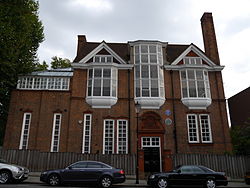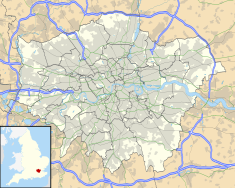8 Melbury Road
| 8 Melbury Road | |
|---|---|

8 Melbury Road
|
|
| Location | Holland Park, West London, England |
| Coordinates | 51°29′57.28″N 0°12′13.49″W / 51.4992444°N 0.2037472°WCoordinates: 51°29′57.28″N 0°12′13.49″W / 51.4992444°N 0.2037472°W |
| Built | 1875 |
| Architect | Richard Norman Shaw |
| Architectural style(s) | Queen Anne style |
| Governing body | Privately owned |
|
Listed Building – Grade II*
|
|
| Official name: 8 Melbury Road | |
| Designated | 30 August 1961 |
| Reference no. | 1225615 |
8 Melbury Road is a large detached house at the Holland Park district of Kensington and Chelsea, W14. Built in the Queen Anne style by the architect Richard Norman Shaw, it is a Grade II* listed building.
It was commissioned by the painter Marcus Stone as a "studio-home" for himself. The house was designed by architect Richard Norman Shaw in the Queen Anne style. Shaw was well acquainted with members of the art establishment, being friends with Dante Gabriel Rossetti, William Morris and Philip Webb. The choice by Fildes and Stone of Richard Norman Shaw as the architect of their houses was an important symbol of their ambition to become academicians, members of the Royal Academy of Arts, and of the art establishment themselves. The imposing houses and studios that Shaw designed would impress potential patrons. The house is next to the home of George Frederick Watts, and backs on to the garden of the Leighton House Museum, the former "studio-home" of Frederic, Lord Leighton. Stone's studio occupied the whole of the first floor of the house. The house is now separated into flats.
Following Stone's death the house was occupied by artist Percyval Tudor-Hart. The film director Michael Powell lived at the house from 1951 to 1971 and shot parts of his controversial 1960 film Peeping Tom at the house.
...
Wikipedia

